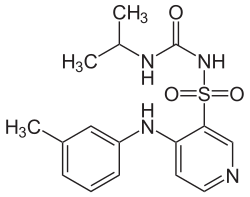Chemistry:Torasemide
 | |
| Clinical data | |
|---|---|
| Trade names | Demadex, Tortas, Wator |
| Other names | Torsemide, Torsemide (USAN US) |
| AHFS/Drugs.com | Monograph |
| MedlinePlus | a601212 |
| License data | |
| Routes of administration | By mouth, intraveneous |
| Drug class | Loop diuretic |
| ATC code | |
| Legal status | |
| Legal status |
|
| Pharmacokinetic data | |
| Bioavailability | 80-90% |
| Protein binding | Highly bound (>99%). |
| Metabolism | Liver (80%) |
| Elimination half-life | 3.5 hours; Cirrhosis: 7-8 hours |
| Identifiers | |
| |
| CAS Number | |
| PubChem CID | |
| IUPHAR/BPS | |
| DrugBank | |
| ChemSpider | |
| UNII | |
| KEGG | |
| ChEBI | |
| ChEMBL | |
| Chemical and physical data | |
| Formula | C16H20N4O3S |
| Molar mass | 348.42 g·mol−1 |
| 3D model (JSmol) | |
| |
| |
| | |
Torasemide, also known as torsemide, is a diuretic medication used to treat fluid overload due to heart failure, kidney disease, and liver disease. It is a less preferred treatment for high blood pressure.[1] It is taken by mouth or by injection into a vein.[1]
Common side effects include headache, increased urination, diarrhea, cough, and dizziness.[1] Other side effects may include hearing loss and low blood potassium.[1] Torasemide is a sulfonamide and loop diuretic.[1] Use is not recommended in pregnancy or breastfeeding.[2] It works by decreasing the reabsorption of sodium by the kidneys.[1]
Torasemide was patented in 1974 and came into medical use in 1993.[3] It is on the World Health Organization's List of Essential Medicines.[4] It is available as a generic medication.[2] In 2020, it was the 213th most commonly prescribed medication in the United States, with more than 2 million prescriptions.[5][6]
Medical uses
It is used to treat fluid overload due to heart failure. It is sometimes used to treat high blood pressure.[1] Compared with furosemide, torasemide is associated with a lower risk of rehospitalization for heart failure and an improvement in New York Heart Association class of heart failure.[7][8][9] In heart failure it may be safer and more effective than furosemide.[10][11][12] Long-term outcomes with torasemide may be better than with furosemide in patients with heart failure.[13]
Adverse effects
No evidence of torasemide-induced ototoxicity has been demonstrated in humans.[14]
Loop diuretics, including torsemide, may decrease total body thiamine, particularly in people with poor thiamine intake, and this depletion may worsen heart failure. It is therefore reasonable to either also give thiamine supplements or to check blood thiamine levels in those being treated with chronic loop diuretics.[15]
Chemistry
Compared with other loop diuretics, torasemide has a more prolonged diuretic effect than equipotent doses of furosemide and relatively decreased potassium loss.
Names
Torasemide is the recommended name of the drug (rINN) according to the (INN), which is the drug naming system coordinated by the World Health Organization. Torsemide is the official name of the drug according to the (USAN), which is the drug naming system coordinated by the USAN Council, which is co-sponsored by the American Medical Association (AMA), the United States Pharmacopeial Convention (USP), and the American Pharmacists Association (APhA).
References
- ↑ 1.0 1.1 1.2 1.3 1.4 1.5 1.6 "Torsemide Monograph for Professionals". American Society of Health-System Pharmacists. https://www.drugs.com/monograph/torsemide.html. Retrieved 18 March 2019.
- ↑ 2.0 2.1 British national formulary : BNF 76 (76 ed.). Pharmaceutical Press. 2018. pp. 227–228. ISBN 9780857113382.
- ↑ Analogue-based Drug Discovery. John Wiley & Sons. 2006. p. 458. ISBN 9783527607495. https://books.google.com/books?id=FjKfqkaKkAAC&pg=PA458.
- ↑ World Health Organization model list of essential medicines: 22nd list (2021). Geneva: World Health Organization. 2021. WHO/MHP/HPS/EML/2021.02.
- ↑ "The Top 300 of 2020". https://clincalc.com/DrugStats/Top300Drugs.aspx.
- ↑ "Torsemide - Drug Usage Statistics". https://clincalc.com/DrugStats/Drugs/Torsemide.
- ↑ "Meta-Analysis Comparing Torsemide Versus Furosemide in Patients With Heart Failure". Am. J. Cardiol. 125 (1): 92–99. January 2020. doi:10.1016/j.amjcard.2019.09.039. PMID 31699358.
- ↑ "READY: relative efficacy of loop diuretics in patients with chronic systolic heart failure-a systematic review and network meta-analysis of randomised trials". Heart Fail Rev 24 (4): 461–472. March 2019. doi:10.1007/s10741-019-09771-8. PMID 30874955.
- ↑ "Torsemide versus furosemide and intermediate-term outcomes in patients with heart failure: an updated meta-analysis". J Cardiovasc Med (Hagerstown) 20 (6): 379–388. June 2019. doi:10.2459/JCM.0000000000000794. PMID 30950982.
- ↑ "A comprehensive review of the loop diuretics: should furosemide be first line?". Ann Pharmacother 43 (11): 1836–47. November 2009. doi:10.1345/aph.1M177. PMID 19843838.
- ↑ "Diuretics: a review and update". J. Cardiovasc. Pharmacol. Ther. 19 (1): 5–13. 2014. doi:10.1177/1074248413497257. PMID 24243991.
- ↑ "A reappraisal of loop diuretic choice in heart failure patients". Am. Heart J. 169 (3): 323–33. 2015. doi:10.1016/j.ahj.2014.12.009. PMID 25728721.
- ↑ "Comparative Analysis of Long-Term Outcomes of Torasemide and Furosemide in Heart Failure Patients in Heart Failure Registries of the European Society of Cardiology". Cardiovascular Drugs and Therapy 33 (1): 77–86. February 2019. doi:10.1007/s10557-018-6843-5. PMID 30649675.
- ↑ "Torasemide. An update of its pharmacological properties and therapeutic efficacy". Drugs 49 (1): 121–42. January 1995. doi:10.2165/00003495-199549010-00009. PMID 7705212.
- ↑ "Thiamine Therapy for Heart Failure: a Promise or Fiction?". Cardiovasc Drugs Ther 32 (4): 313–317. August 2018. doi:10.1007/s10557-018-6808-8. PMID 30022355.
External links
- "Torasemide". Drug Information Portal. U.S. National Library of Medicine. https://druginfo.nlm.nih.gov/drugportal/name/torasemide.
 |

